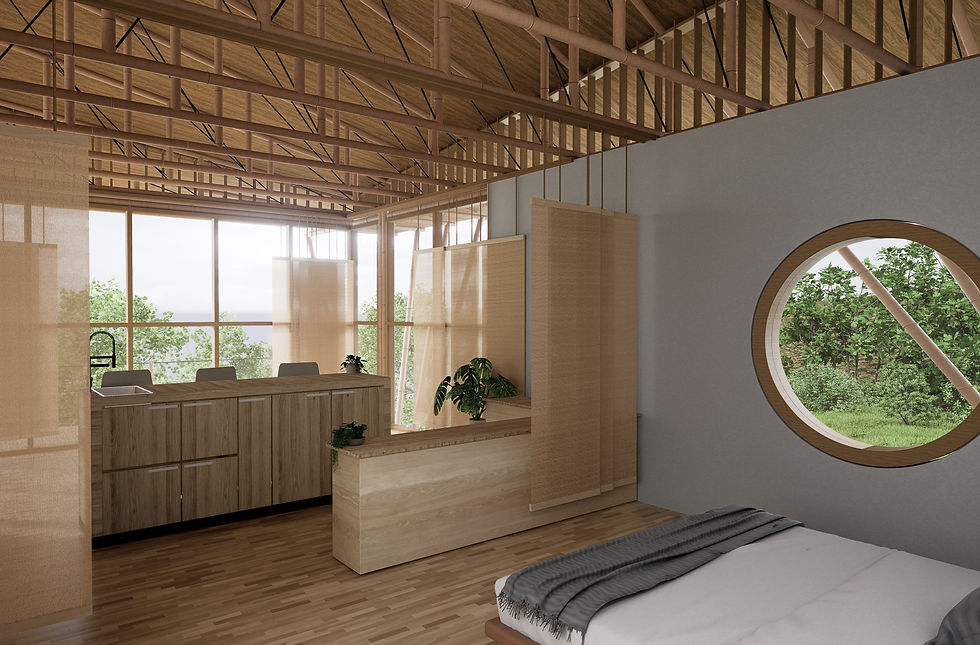What is Cement Bamboo Frame Technology? Why We Are Eager to Bring It to Nepal
- Geetika Khatri

- Mar 7
- 4 min read
For years, I’ve watched brick and concrete structures dominate the urban landscape in Nepal. As an architect, I have even designed and lived in these buildings. There is definitely a certain comfort in their familiarity now. But I think it is time to snap out of this partial complacency and confront the truth—how much longer can we ignore the devastating environmental cost of our choices?
The more I reflected on it, the clearer it became that a shift toward more natural alternatives is where I should focus my efforts, with bamboo being one of the key materials I now embrace as part of the Archiformus team.
Grown abundantly in many parts of Nepal, bamboo is a renewable material that offers both sustainability and strength. In this blog, I explore Cement Bamboo Frame Technology, which has recently been gaining attention in Nepal.

How is Cement Bamboo Frame Technology (CBFT) Constructed?
Material Selection & Treatment
Bamboo poles are chosen for strength, flexibility, and sustainability.
Treated with borax soaking or heat treatment for durability against pests and rot.
Structural Framework
Treated bamboo forms the primary frame, secured with metal connectors, brackets, or straps.
Cement is applied at key joints for reinforcement.

Walls & Reinforcement
Bamboo woven panels or metal mesh serve as walls, coated with cement-based plaster for durability.
Cement blocks or bricks may be added to lower walls for extra stability.
Roof Construction
Built using bamboo trusses or metal frame, covered with waterproof materials like metal sheets or tiles.
Cement can reinforce truss joints for added strength.
Foundation & Flooring
Reinforced concrete slab or footings anchor the structure.
Various options for flooring as per design needs.
Final Touches
A final cement plaster layer is applied to walls.
Eco-friendly paint enhances durability and aesthetics.

Why is Cement Bamboo Frame Technology Eco-Friendly Despite Using Cement and Concrete?
Conventional Construction Methods in Nepal
Traditional building methods in Nepal rely heavily on cement and fired bricks, which has a high carbon footprint due to its energy-intensive production.
Cement manufacturing releases large amounts of CO2, contributing to global warming.
Fired bricks require significant energy for high-temperature firing, and often uses coal or wood as fuel, resulting in pollutants and carbon emissions.
Concrete hollow blocks, though lighter than fired bricks and offering some insulation, still require substantial cement, maintaining a considerable environmental impact.
The Sustainable Advantage of Cement Bamboo Frame Technology (CBFT)
Cement usage in CBFT is much smaller compared to reinforced concrete (RCC) construction.
Bamboo processing uses far less energy than the production of fired bricks and concrete blocks.
Bamboo is a renewable material that grows rapidly, absorbing CO2 as it grows and helping offset some emissions from cement production.
Harvesting bamboo only takes 3 to 5 years, making it a far more sustainable resource than the non-renewable materials used in conventional construction.
By choosing CBFT, we move toward a more sustainable, eco-friendly building solution that reduces the environmental burden of conventional construction materials.
How is CBFT an earthquake resistant technology?
Cement bamboo frame technology is earthquake-resistant because it combines the inherent flexibility and tensile strength of bamboo with the durability and rigidity of cement. Bamboo, being lightweight and elastic, can absorb and dissipate seismic energy, reducing the risk of structural collapse during an earthquake.
The lightweight nature of the structure also reduces the overall load on the foundation, minimizing the risk of ground settlement and improving stability in areas with weak soil or unstable ground.
Additionally, a lighter structure sways more effectively during seismic events, helping to dissipate the earthquake’s energy without sustaining significant damage. The cement reinforcement enhances the connections between bamboo components, ensuring stability and robustness in the overall frame.
This combination creates a structure that can bend without breaking, adapt to dynamic earthquake forces, and withstand lateral shaking, making it a suitable and sustainable construction solution for earthquake-prone regions.
Current situation of Cement Bamboo Frame Technology in Nepal

The 2015 earthquake in Nepal and rising environmental concerns prompted a few local experts and concerned professionals to incorporate this building method into the national bamboo building guidelines.
And while efforts to further refine the technology continue, it is currently suitable for small-scale private houses. In fact, although the building guidelines await full government approval, the proven structural feasibility has enabled the construction of over 500 small-scale houses nationwide, partially funded by the government.
Cement Bamboo Frame Technology (CBFT) is not primitive; it’s an innovative and forward-thinking response to modern construction’s environmental challenges. By combining local materials with contemporary techniques, it offers a sustainable alternative.
Our Path Forward
Our team here at Archiformus is passionate about integrating innovative and sustainable solutions into our future projects. One such proposal we recently put forward is for a small-scale, eco-friendly house in Begnas, Nepal, where we’ve suggested utilizing CBFT. We have proposed a concept that combines a lightweight structure that is resilient to earthquake, with aesthetic flexibility. While we are in the process of finalizing the design with the client, we look forward to soon sharing further insights into the proposal and its potential impact on sustainable housing in Nepal.



Comments